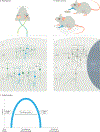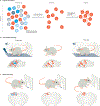Encouraging an excitable brain state: mechanisms of brain repair in stroke
- PMID: 33184469
- PMCID: PMC10625167
- DOI: 10.1038/s41583-020-00396-7
Encouraging an excitable brain state: mechanisms of brain repair in stroke
Abstract
Stroke induces a plastic state in the brain. This period of enhanced plasticity leads to the sprouting of new axons, the formation of new synapses and the remapping of sensory-motor functions, and is associated with motor recovery. This is a remarkable process in the adult brain, which is normally constrained in its levels of neuronal plasticity and connectional change. Recent evidence indicates that these changes are driven by molecular systems that underlie learning and memory, such as changes in cellular excitability during memory formation. This Review examines circuit changes after stroke, the shared mechanisms between memory formation and brain repair, the changes in neuronal excitability that underlie stroke recovery, and the molecular and pharmacological interventions that follow from these findings to promote motor recovery in animal models. From these findings, a framework emerges for understanding recovery after stroke, central to which is the concept of neuronal allocation to damaged circuits. The translation of the concepts discussed here to recovery in humans is underway in clinical trials for stroke recovery drugs.
Figures




References
-
- Benjamin EJ et al. Heart Disease and Stroke Statistics-2019 Update: A Report From the American Heart Association. Circulation 139, e56–e528 (2019). - PubMed
-
- Faul M, Xu L, Wald MM & Coronado VG Traumatic brain injury in the United States: emergency department visits, hospitalizations, and deaths. Atlanta (GA): Centers for Disease Control and Prevention. Natl. Cent. Inj. Prev. Control 2, (2010).
-
- Song SS Advanced imaging in acute ischemic stroke. Semin. Neurol. 33, 436–440 (2013). - PubMed
-
- Fisher M & Albers GW Advanced imaging to extend the therapeutic time window of acute ischemic stroke. Ann. Neurol. 73: 4–9 (2013). - PubMed
-
- Sandhu GS & Sunshine JL Advanced neuroimaging to guide acute stroke therapy. Curr. Cardiol. Rep. 14, 741–753 (2012). - PubMed

